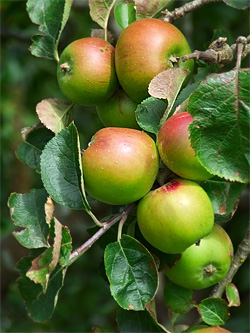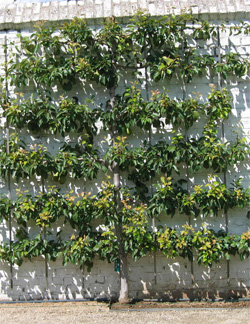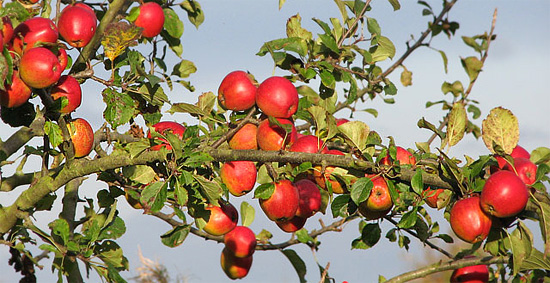 image via Wikimedia Commons
image via Wikimedia Commons
Apple trees will grow just about anywhere that has cool or cold winters. That means they’ll grow in much of the United States except for the hottest regions. Dwarf varieties can start bearing small crops of fruit in their third year, while full-sized apple trees don’t usually start producing until their fifth year. However, once they start producing, dwarf, semi-dwarf, and full-sized trees can provide you with apples for decades.
Apple Tree Diseases
To prevent most diseases, simply start with healthy trees, nourish them well, provide plenty of air, and keep your orchard clean. Cedar rust, scab, or fire blight can be common in some areas. Simply ask at your local nursery if you need to purchase a variety that is resistant to those diseases or other problem diseases in your area. Choose trees that are free of mildew, broken branches, yellowing leaves, or anything that doesn’t look “healthy.”
A number of molds, mildews, and other diseases can be prevented by careful management. Don’t allow old apples to cling to a tree, or fallen apples or branches to lie on the ground. Prune out anything that looks unhealthy, not only from your apple trees, but any other nearby trees as well. Burn all pruned material far away from your orchard.
Waterlogged soil can produce root rot, so make sure your soil drains well. Apple trees like a pH of 6.0 to 8.0, so check ph before planting. Using clover or another legume as a cover crop will produce nitrogen in a form that tree roots can take up easily, nourishing the trees, which helps them resist diseases. Clover also attracts bees, which will pollinate the flowers.
Another way to prevent disease is to use garlic oil. Soak a cup of chopped garlic in a quart of mineral oil for 24 hours. Then strain out the garlic and spray the oil on the trunk and branches of the tree. Not only does this help prevent diseases, but it often discourages deer from eating your apples.
Dwarf Apple Trees
 A dwarf apple tree can be trimmed
A dwarf apple tree can be trimmedinto an espalier shape to save room.
Image: Wikimedia Commons
Apple trees come in three sizes, full-sized, which can reach up to 25 feet, semi-dwarf varieties which are generally 12 to 15 feet tall, and dwarf trees that grow 7-10 feet tall. Dwarf varieties are generally the easiest to harvest and prune, and produce yields that rival the larger trees.
Dwarf apple trees can come in many varieties. The rootstock, essentially the bottom part of the tree, determines the overall size. Grafting a variety of apple tree onto a regular rootstock will produce a normal-sized tree. Grafting the same variety onto a dwarf rootstock will produce a dwarf tree of the same variety. If the growing conditions are good, the fruit will even be the same size as those grown on full-sized trees.
Cross-Pollination
One other item must be mentioned: you cannot plant a single apple tree unless it is a self-pollinating variety, or there are compatible trees nearby to pollinate it. However, even self-fertile varieties will produce more fruit if cross pollinated with a different variety.
Self-pollinators include, but are not limited to, Golden Delicious, Winesap, Granny Smith, Jonathan, and Red Rome. Sometimes, nurseries will graft a cross-pollinating branch onto a tree that needs cross-pollination and call it a self-pollinating variety. However, if that branch becomes damaged or diseased, the tree may stop producing fruit.
Good cross-pollinators will pollinate compatible trees, while being pollinated and becoming fruitful from those same trees. For example, Braeburn apple trees will pollinate Fuji, Gala, Honey Crisp, McIntosh, and Red Delicious. In return, those varieties will pollinate the Braeburn trees. Red Delicious will pollinate just about every variety except Jonagold. However, Red Delicious is not self-pollinating and needs a different variety nearby.
So, are you ready to plant some apple trees? Why not try just two varieties to start? With a little care, they can provide food for you and your family for years to come.

Even wild apples can produces an abundant, beautiful crop.
If nothing else you can make hard cider from these beauties!
Image from Geograph.org.uk.
Further Reading
Growing Apples, Malus domestica at Old Farmer's Almanac.